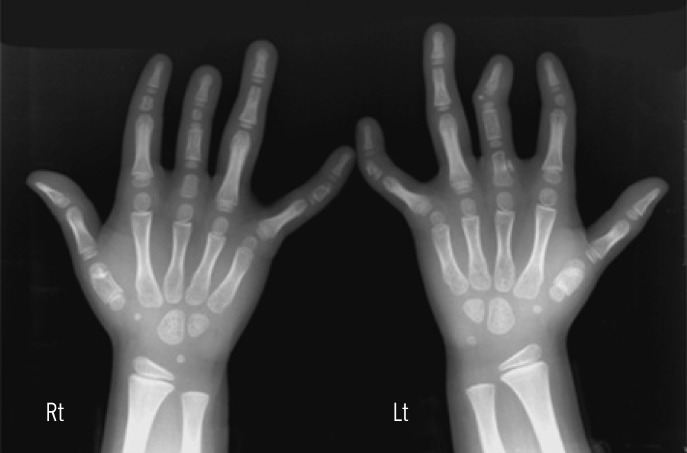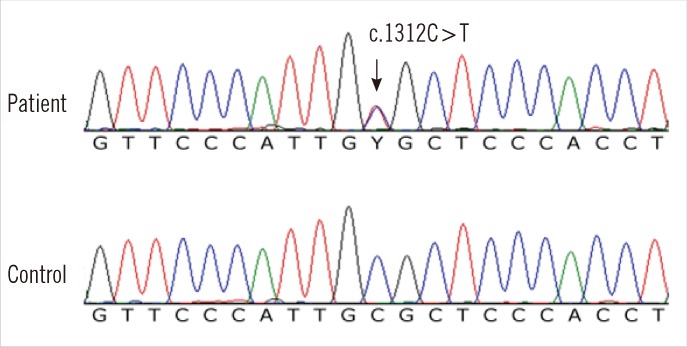Ann Lab Med.
2013 Mar;33(2):150-152. 10.3343/alm.2013.33.2.150.
Identification of a GDF5 Mutation in a Korean Patient with Brachydactyly Type C without Foot Involvement
- Affiliations
-
- 1Department of Laboratory Medicine, Seoul National University Hospital, Seoul, Korea. mwseong@snu.ac.kr
- 2Department of Pediatrics, Sanggye Paik Hospital, Inje University College of Medicine, Seoul, Korea.
- 3Department of Radiology, Ajou University Hospital, Suwon, Korea.
- KMID: 1781317
- DOI: http://doi.org/10.3343/alm.2013.33.2.150
Abstract
- Brachydactyly type C (BDC) is characterized by shortening of the middle phalanges of the index, middle, and little fingers. Hyperphalangy of the index and middle finger and shortening of the first metacarpal can also be observed. BDC is a rare genetic condition associated with the GDF5 gene, and this condition has not been confirmed by genetic analysis so far in the Korean population. Herein, we present a case of a 6-yr-old girl diagnosed with BDC confirmed by molecular genetic analysis. The patient presented with shortening of the second and third digits of both hands. Sequence analysis of the GDF5 gene was performed and the pathogenic mutation, c.1312C>T (p.Arg438Cys), was identified. Interestingly, this mutation was previously described in a patient who presented with the absence of the middle phalanges in the second through fifth toes. However, our patient showed no involvement of the feet. Considering intrafamilial and interfamilial variability, molecular analysis of isolated brachydactyly is warranted to elucidate the genetic origin and establish a diagnosis.
Keyword
MeSH Terms
Figure
Reference
-
2. Schwabe GC, Türkmen S, Leschik G, Palanduz S, Stöver B, Goecke TO, et al. Brachydactyly type C caused by a homozygous missense mutation in the prodomain of CDMP1. Am J Med Genet A. 2004; 124A:356–363. PMID: 14735582.
Article3. Seemann P, Schwappacher R, Kjaer KW, Krakow D, Lehmann K, Dawson K, et al. Activating and deactivating mutations in the receptor interaction site of GDF5 cause symphalangism or brachydactyly type A2. J Clin Invest. 2005; 115:2373–2381. PMID: 16127465.
Article4. Savarirayan R, White SM, Goodman FR, Graham JM Jr, Delatycki MB, Lachman RS, et al. Broad phenotypic spectrum caused by an identical heterozygous CDMP-1 mutation in three unrelated families. Am J Med Genet A. 2003; 117A:136–142. PMID: 12567410.
Article5. Baek GH, Chung MS, Park YB, Yoo KH. The relative incidence of congenital anomalies of the hand. J Korean Orthop Assoc. 1997; 32:796–801.
Article6. Everman DB, Bartels CF, Yang Y, Yanamandra N, Goodman FR, Mendoza-Londono JR, et al. The mutational spectrum of brachydactyly type C. Am J Med Genet. 2002; 112:291–296. PMID: 12357473.
Article7. Polinkovsky A, Robin NH, Thomas JT, Irons M, Lynn A, Goodman FR, et al. Mutations in CDMP1 cause autosomal dominant brachydactyly type C. Nat Genet. 1997; 17:18–19. PMID: 9288091.
Article8. Holder-Espinasse M, Escande F, Mayrargue E, Dieux-Coeslier A, Fron D, Doual-Bisser A, et al. Angel shaped phalangeal dysplasia, hip dysplasia, and positional teeth abnormalities are part of the brachydactyly C spectrum associated with CDMP-1 mutations. J Med Genet. 2004; 41:e78. PMID: 15173244.
Article9. Yang W, Cao L, Liu W, Jiang L, Sun M, Zhang D, et al. Novel point mutations in GDF5 associated with two distinct limb malformations in Chinese: brachydactyly type C and proximal symphalangism. J Hum Genet. 2008; 53:368–374. PMID: 18283415.
Article
- Full Text Links
- Actions
-
Cited
- CITED
-
- Close
- Share
- Similar articles
-
- A familial case with brachydactyly type C with a GDF5 mutation
- Identification of p.Glu131Lys Mutation in the IHH Gene in a Korean Patient With Brachydactyly Type A1
- A frameshift mutation in the TRPS1 gene showing a mild phenotype of trichorhinophalangeal syndrome type 1
- Novel Mutation in PTHLH Related to Brachydactyly Type E2 Initially Confused with Unclassical Pseudopseudohypoparathyroidism
- Systemic Blastomycosis with Osseous Involvement of the Foot: A Case Report



